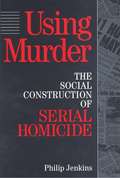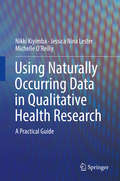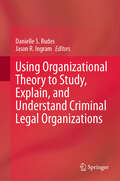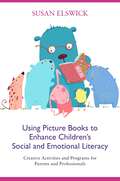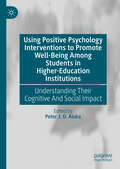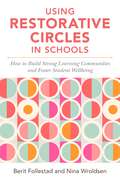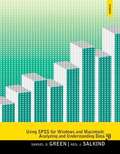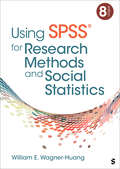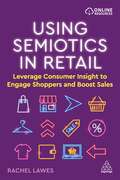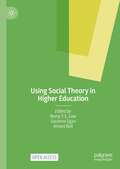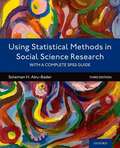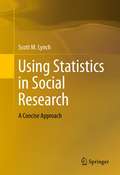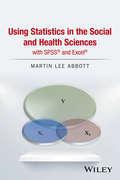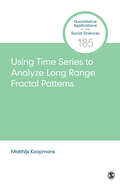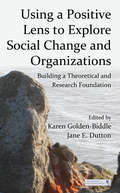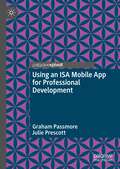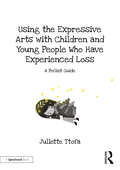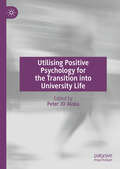- Table View
- List View
Using Murder: The Social Construction of Serial Homicide (Social Problems And Social Issues Ser.)
by Philip JenkinsFirst published in 1994, this book investigates the social construction of serial homicide and assesses the concern that popular fears and stereotypes have exaggerated: the actual scale of multiple homcide. Jenkins has produced an innovative synthesis of approaches to social problem construction that includes an historical and social-scientific estimate of the objective scale of serial murder; a rhetorical analysis of the contruction of the phenomenom in public debate; a cultural studies-oriented analysis of the portrayal of serial murder in contemorary media. Chapters include: "The Construction of Problems and Panic," which covers areas such as comprehending murder, dangerous outsiders, and the rhetoric of perscution; "The Reality of Serial Murder," which discusses statistics, stereotype examination, and media patterns;"Popular Culture: Images of the Serial Killer"; "The Racial Dimension: Serial Murder as Bias Crime"; and "Darker than We Imagine"; "Cults and Conspiracies."
Using Naturally Occurring Data in Qualitative Health Research: A Practical Guide
by Michelle O'Reilly Jessica Nina Lester Nikki KiyimbaThis highly practical resource brings new dimensions to the utility of qualitative data in health research by focusing on naturally occurring data. It examines how naturally occurring data complement interviews and other sources of researcher-generated health data, and takes readers through the steps of identifying, collecting, analyzing, and disseminating these findings in ethical research with real-world relevance. The authors acknowledge the critical importance of evidence-based practice in today’s healthcare landscape and argue for naturally occurring data as a form of practice-based evidence making valued contributions to the field. And chapters evaluate frequently overlooked avenues for naturally occurring data, including media and social media sources, health policy and forensic health contexts, and digital communications. Included in the coverage:· Exploring the benefits and limitations of using naturally occurring data in health research · Considering qualitative approaches that may benefit from using naturally occurring data · Utilizing computer-mediated communications and social media in health · Using naturally occurring data to research vulnerable groups · Reviewing empirical examples of health research using naturally occurring data Using Naturally Occurring Data in Qualitative Health Research makes concepts, methods, and rationales accessible and applicable for readers in the health and mental health fields, among them health administrators, professionals in research methodology, psychology researchers, and practicing and trainee clinicians.
Using Organizational Theory to Study, Explain, and Understand Criminal Legal Organizations
by Danielle S. Rudes Jason R. IngramThis book explicitly and intentionally uses organizational theory concepts and ideas to examine key issues in the criminal legal realm. Addressing some of the many organizational theories, this volume examines a variety of approaches and theoretical frameworks to explore and explain challenges that are both presented to and faced by the criminal legal system and the individuals served by or working within it. This volume is divided into two parts: organizational theories and organizational concepts and ideas. Within these parts, individual chapters provide readers with new lenses or frameworks for considering criminal legal organization, including one that involves organizational theoretical explanations for how and why criminal legal organizations and their staff and workers operate in these critically salient spaces. The book concludes with a chapter that outlines important considerations for anyone seeking to learn or teach organizational theory as a way of explaining or understanding criminal legal organizations. Additional reading suggestions and two sample syllabi are provided. The book is ideal for criminal justice and criminology undergraduate and graduate students, but is also relevant to individuals considering criminal legal organizations in courses in sociology, law and society, and organizational behavior.
Using Picture Books to Enhance Children’s Social and Emotional Literacy: Creative Activities and Programs for Parents and Professionals
by Susan ElswickChildren can struggle to engage with and articulate certain emotions, which can have a profound impact on their behaviour, confidence and ability to form relationships, follow instructions and perform tasks. This resource for teachers, therapists, counsellors and parents uses children's literature and some of its well-known characters, such as the Rainbow Fish and Stanley Yelnats IV from Holes, as a basis for practical activities that enable children to express and manage these emotions. Social-emotional literacy training assists students in developing important life skills such as the ability to develop good relationships and empathy skills, as well as being able to understand, manage and communicate their own emotions. This book offers an introduction to social-emotional literacy, followed by activities related to emotions such as empathy, friendship, grief and self-esteem, aiming to embed this literacy training into daily school and home activities to increase children's chances of future success.
Using Positive Psychology Interventions to Promote Well-Being Among Students in Higher-Education Institutions: Understanding Their Cognitive And Social Impact
by Peter J. O. AlokaThis book explores positive psychology interventions; strategies which are aimed at enhancing positive emotions, cognitions and happiness among students in higher education institutions. Students worldwide have reported increased psychosocial issues which negatively affect their overall well-being and mental health. The poor well-being and mental health of university students has led to among other things, high attrition rate, suicide cases, low academic performance, and increased psychological and social problems among them. There has been increased interest in reach on the well-being and mental health of students in higher education. However, despite this, there is still scanty research on positive psychology interventions that could be adopted to boost well-being and mental health of students in higher education institutions. This book significantly contributes to the body of knowledge on adoption of holistic perspectives to boost well-being and mental health of students in higher education institutions.
Using Restorative Circles in Schools: How to Build Strong Learning Communities and Foster Student Wellbeing
by Nina Wroldsen Berit FollestadRestorative circles are an effective way of implementing restorative justice, through starting a conversation wider than just the victim and the offender. Proven to be an effective way of healing and building relationships, tackling bullying within schools and providing a sense of community, this book gives everything needed for a school to start implementing restorative circles.Accompanied by illustrations, interviews and case studies to show how to start using restorative circles, this practical guide is the perfect introduction for schools looking to improve their methods of conflict resolution.
Using SPSS for Windows and Macintosh: Analyzing and Understanding Data
by Neil Salkind Samuel GreenThe development of easy-to-use statistical software like SPSS has changed the way statistics is being taught and learned. Even with these advancements, however, students sometimes still find statistics a tough nut to crack. Using SPSS for Windows and Macintosh, 7/e, guides students through basic SPSS techniques using step-by-step descriptions and explaining in detail how to avoid common pitfalls in the study of statistics.
Using SPSS® for Research Methods and Social Statistics
by William E. Wagner-HuangThis is the perfect companion for students who are learning to use the SPSS software to interpret and manage data. Students will appreciate author William E. Wagner-Huang’s step-by-step explanations of SPSS operating procedures and introductory statistical operations. The Eighth Edition uses version 29 of the software and incorporates results from the 2022 General Social Survey (GSS) as a dataset used in examples throughout the book. In response to user feedback, the author has expanded the sections on ANOVA and chi-square. The GSS datasets and codebooks for use with the text are available on an accompanying website.
Using SPSS® for Research Methods and Social Statistics
by William E. Wagner-HuangThis is the perfect companion for students who are learning to use the SPSS software to interpret and manage data. Students will appreciate author William E. Wagner-Huang’s step-by-step explanations of SPSS operating procedures and introductory statistical operations. The Eighth Edition uses version 29 of the software and incorporates results from the 2022 General Social Survey (GSS) as a dataset used in examples throughout the book. In response to user feedback, the author has expanded the sections on ANOVA and chi-square. The GSS datasets and codebooks for use with the text are available on an accompanying website.
Using Scenarios: Scenario Planning for Improving Organizations
by Thomas J. ChermackThis is the first book to offer detailed guidance on how scenarios can be used to help organizations make their toughest decisions in a world of ever-escalating crisis and opportunity.To reap the full benefits of scenarios, you have to be able to apply them in the real world. This groundbreaking book goes beyond the theoretical to clearly explain different ways scenarios can be used in business decision-making—from strategic planning and financial modeling to crisis response. Connecting scenarios to strategy and action can have many benefits, including the ability to react quickly, anticipate major changes in the environment, and identify major opportunities. Thomas Chermack, a top expert on scenario planning, offers seven specific ways organizations can use scenarios and provides a wide variety of examples, along with proven processes, exercises, and workshops that have been used successfully in organizations across industries and countries for more than fifteen years.
Using Semiotics in Marketing: How to Achieve Consumer Insight for Brand Growth and Profits
by Dr Rachel LawesSemiotics is big business. It is most famous for its unique ability to decode visual images, and is the only market research method which provides a systematic, reliable and culturally sensitive method for interpreting what visual images mean. Semiotics sheds new light on consumers and the world they live in, stimulates creativity and innovation, guides brand strategy, and finds solutions to a plethora of marketing problems. Using Semiotics in Marketing will help marketers looking to launch new brands, reposition existing brands, or rejuvenate established brands. In what can seem a complex and abstract field, it is an invaluably clear, practical resource on how to seize the tremendous opportunity that semiotics offers.Written by one of the original founders of commercial semiotics, Using Semiotics in Marketing outlines precisely what semiotics is and why it matters, before moving on to demonstrate how to run a successful commercial semiotics project. Packed with fascinating case studies proving how visual imagery is interpreted differently across cultural, racial and social demographics, it provides essential insights into understanding consumers. This results in better ads, websites, packaging and social media content - ultimately driving brand growth and profits.
Using Semiotics in Marketing: How to Achieve Consumer Insight for Brand Growth and Profits
by Dr Rachel LawesSemiotics is a superpower for marketers. It's a proven, powerful method of uncovering consumer insight, tailoring brand strategies that work and generating profit for brands.Companies such as Unilever and P&G have attested to the success of Lawes semiotics in stimulating innovation and boosting sales. Now newly updated, this second edition is packed with even more revelations about brands, consumers and their emerging needs. Three new chapters reveal the unseen social forces that drive the Be Kind movement, public appetite for sincerity and the emotions of younger generations.Using Semiotics in Marketing is an acclaimed how-to guide that makes semiotics accessible. It ensures all agency-side and client-side marketers can pick up the skills to use and apply semiotics to brands and is the only book on semiotics ever published that sets out a complete blueprint for research projects. This is your one-stop guide to learn how to write briefs and proposals, design projects, conduct analysis, write reports and present research findings.Start using semiotics today. Position and launch new brands, rejuvenate established ones, design products and packaging and inspire timely and provocative ad campaigns. See the future. Innovate.
Using Semiotics in Retail: Leverage Consumer Insight to Engage Shoppers and Boost Sales
by Dr Rachel LawesBoosting retail sales is more important than ever. Stand out in a global, digital marketplace, grow customer loyalty and evolve your brand by leveraging the power of semiotics online and in physical stores.Practical, accessible and based on 20 years of global marketing experience, Using Semiotics in Retail shows retailers of all sizes how to upgrade and empower their marketing, today and for the future. Discover step-by-step how to recognise and design for emerging consumer needs and create meaningful shopper experiences. Learn how to surprise and delight consumers, increase engagement and make shopping easier for everyone. It features case studies and examples from Unilever, Freshippo, H&M, Google, Toyota and many more.Using Semiotics in Retail shares game-changing marketing insights in categories such as FMCG, fashion, technology and entertainment, drawn from China, India, Mexico, the US and the UK. The book is supported by online resources that include templates and interactive exercises. Using Semiotics in Retail equips readers with a set of powerful tools which readers can use straight away to create engaging and successful retail marketing.
Using Social Theory in Higher Education
by Suzanne Egan Amani Bell Remy Y. S. LowThis open access book offers a unique and refreshing view on working with social theory in higher education. Using engaging first-person accounts coupled with critical intellectual analysis, the authors demonstrate how theory is grappled with as part of an ongoing practice rather than a momentary disembodied encounter. In a structure that creates a space for relational dialogue, each chapter is followed by a response from another author, demonstrating the varied interpretive possibilities of social theory. Collectively the authors invite the reader to engage with them in questioning the usefulness of social theory in higher education teaching and research, in considering its possibilities and limits, and in experiencing the opportunity it offers to understand ourselves and our work differently. Written in a way that is scholarly yet accessible, the contributors explore how social theories can be used to think through issues that are emerging as key social and political concerns in higher education and beyond. The book will be of interest to advanced undergraduates, postgraduates, and early-career academics, as well as established scholars.
Using Statistical Methods in Social Science Research: With a Complete SPSS Guide
by Soleman H. Abu-BaderUsing Statistical Methods in Social Science Research, Third Edition is the user-friendly text every student needs for analyzing and making sense of quantitative data. With over 20 years of experience teaching statistics, Soleman H. Abu-Bader provides an accessible, step-by-step description of the process needed to organize data, choose a test or statistical technique, analyze, interpret, and report research findings. <p><p>The book begins with an overview of research and statistical terms, followed by an explanation of basic descriptive statistics. It then focuses on the purpose, rationale, and assumptions made by each test, such as Pearson's correlation, student's t-tests, analysis of variances, and simple linear regression, among others. The book also provides a wealth of research examples that clearly display the applicability and function of these tests in real-world practice. In a separate appendix, the author provides a step-by-step process for calculating each test for those who still like to understand the mathematical formulas behind these processes.
Using Statistics in Social Research
by Scott M. LynchThis book covers applied statistics for the social sciences with upper-level undergraduate students in mind. The chapters are based on lecture notes from an introductory statistics course the author has taught for a number of years. The book integrates statistics into the research process, with early chapters covering basic philosophical issues underpinning the process of scientific research. These include the concepts of deductive reasoning and the falsifiability of hypotheses, the development of a research question and hypotheses, and the process of data collection and measurement. Probability theory is then covered extensively with a focus on its role in laying the foundation for statistical reasoning and inference. After illustrating the Central Limit Theorem, later chapters address the key, basic statistical methods used in social science research, including various z and t tests and confidence intervals, nonparametric chi square tests, one-way analysis of variance, correlation, simple regression, and multiple regression, with a discussion of the key issues involved in thinking about causal processes Concepts and topics are illustrated using both real and simulated data The penultimate chapter presents rules and suggestions for the successful presentation of statistics in tabular and graphic formats, and the final chapter offers suggestions for subsequent reading and study.
Using Statistics in the Social and Health Sciences with SPSS and Excel
by Martin Lee AbbottProvides a step-by-step approach to statistical procedures to analyze data and conduct research, with detailed sections in each chapter explaining SPSS® and Excel® applications This book identifies connections between statistical applications and research design using cases, examples, and discussion of specific topics from the social and health sciences. Researched and class-tested to ensure an accessible presentation, the book combines clear, step-by-step explanations for both the novice and professional alike to understand the fundamental statistical practices for organizing, analyzing, and drawing conclusions from research data in their field. The book begins with an introduction to descriptive and inferential statistics and then acquaints readers with important features of statistical applications (SPSS and Excel) that support statistical analysis and decision making. Subsequent chapters treat the procedures commonly employed when working with data across various fields of social science research. Individual chapters are devoted to specific statistical procedures, each ending with lab application exercises that pose research questions, examine the questions through their application in SPSS and Excel, and conclude with a brief research report that outlines key findings drawn from the results. Real-world examples and data from social and health sciences research are used throughout the book, allowing readers to reinforce their comprehension of the material. Using Statistics in the Social and Health Sciences with SPSS® and Excel® includes: * Use of straightforward procedures and examples that help students focus on understanding of analysis and interpretation of findings * Inclusion of a data lab section in each chapter that provides relevant, clear examples * Introduction to advanced statistical procedures in chapter sections (e.g., regression diagnostics) and separate chapters (e.g., multiple linear regression) for greater relevance to real-world research needs Emphasizing applied statistical analyses, this book can serve as the primary text in undergraduate and graduate university courses within departments of sociology, psychology, urban studies, health sciences, and public health, as well as other related departments. It will also be useful to statistics practitioners through extended sections using SPSS® and Excel® for analyzing data. Martin Lee Abbott, PhD, is Professor of Sociology at Seattle Pacific University, where he has served as Executive Director of the Washington School Research Center, an independent research and data analysis center funded by the Bill & Melinda Gates Foundation. Dr. Abbott has held positions in both academia and industry, focusing his consulting and teaching in the areas of statistical procedures, program evaluation, applied sociology, and research methods. He is the author of Understanding Educational Statistics Using Microsoft Excel® and SPSS®, The Program Evaluation Prism: Using Statistical Methods to Discover Patterns, and Understanding and Applying Research Design, also from Wiley.
Using Theory to Explore Health, Medicine and Society
by Peter Kennedy Carole KennedyThis book draws on a broad range of theoretical perspectives to bring to life social theories relating to health and illness. Using case studies it provides contrasting insights into the expanding jurisdiction of medicine over popular issues, including binge drinking, obesity, the prominence of therapy and the search for happiness. The book will appeal to students and academics to show how theory can be applied to issues in health and medicine. It is also relevant reading for health professionals who may lack knowledge of social theory and how it can help to understand the relationship between health, medicine and society. The book will also benefit students in the social sciences who are familiar with social theory and interested in how it can be applied to health, medicine and society.
Using Time Series to Analyze Long-Range Fractal Patterns (Quantitative Applications in the Social Sciences #185)
by Matthijs KoopmansUsing Time Series to Analyze Long Range Fractal Patterns presents methods for describing and analyzing dependency and irregularity in long time series. Irregularity refers to cycles that are similar in appearance, but unlike seasonal patterns more familiar to social scientists, repeated over a time scale that is not fixed. Until now, the application of these methods has mainly involved analysis of dynamical systems outside of the social sciences, but this volume makes it possible for social scientists to explore and document fractal patterns in dynamical social systems. Author Matthijs Koopmans concentrates on two general approaches to irregularity in long time series: autoregressive fractionally integrated moving average models, and power spectral density analysis. He demonstrates the methods through two kinds of examples: simulations that illustrate the patterns that might be encountered and serve as a benchmark for interpreting patterns in real data; and secondly social science examples such a long range data on monthly unemployment figures, daily school attendance rates; daily numbers of births to teens, and weekly survey data on political orientation. Data and R-scripts to replicate the analyses are available on an accompanying website.
Using Time Series to Analyze Long-Range Fractal Patterns (Quantitative Applications in the Social Sciences #185)
by Matthijs KoopmansUsing Time Series to Analyze Long Range Fractal Patterns presents methods for describing and analyzing dependency and irregularity in long time series. Irregularity refers to cycles that are similar in appearance, but unlike seasonal patterns more familiar to social scientists, repeated over a time scale that is not fixed. Until now, the application of these methods has mainly involved analysis of dynamical systems outside of the social sciences, but this volume makes it possible for social scientists to explore and document fractal patterns in dynamical social systems. Author Matthijs Koopmans concentrates on two general approaches to irregularity in long time series: autoregressive fractionally integrated moving average models, and power spectral density analysis. He demonstrates the methods through two kinds of examples: simulations that illustrate the patterns that might be encountered and serve as a benchmark for interpreting patterns in real data; and secondly social science examples such a long range data on monthly unemployment figures, daily school attendance rates; daily numbers of births to teens, and weekly survey data on political orientation. Data and R-scripts to replicate the analyses are available on an accompanying website.
Using Women: Gender, Drug Policy, and Social Justice
by Nancy CampbellFrom the 1950s 'girl junkie' to the 1990s 'crack mom', Using Women investigates how the cultural representations of women drug users have defined America's drug policies in this century. In analyzing the public's continued fear, horror and outrage wrought by the specter of women using drugs, Nancy Campbell demonstrates the importance that public opinion and popular culture have played in regulating women's lives. The book will chronicle the history of women and drug use, provide a critical policy analysis of the government's drug policies and offer recommendations for the direction our current drug policies should take. Using Women includes such chapters as 'Sex, Drugs and Race in the Age of Dope'; 'Regulating Adolescents in the Postwar US'; 'Fifties Femininity'; and 'Regulating Maternal Instinct'.
Using a Positive Lens to Explore Social Change and Organizations: Building a Theoretical and Research Foundation (Organization and Management Series)
by Jane E. Dutton Karen Golden-BiddleHow can application of a positive lens to understanding social change and organizations enrich and elaborate theory and practice? This is the core question that inspired this book. It is a question that brought together a diverse and talented group of researchers interested in change and organizations in different problem domains (sustainability, healthcare, and poverty alleviation). The contributors to this book bring different theoretical lenses to the question of social change and organizations. Some are anchored in more macro accounts of how and why social change processes occur, while others approach the question from a more psychological or social psychological perspective. Many of the chapters in the book travel across levels of analyses, making their accounts of social change good examples of multi-level theorizing. Some scholars are practiced and immersed in thinking about organizational phenomena through a positive lens; for others it was a total adventure in trying on a new set of glasses. However, connecting all contributing authors was an excitement and willingness to explore new insights and new angles on how to explain and cultivate social change within or across organizations. This edited volume will be of interest to an international community who seek to understand how organizations and people can generate positive outcomes for society. Students and researchers in organizational behavior, management, positive psychology, leadership and corporate responsibility will find this book of interest.
Using an ISA Mobile App for Professional Development
by Graham Passmore Julie PrescottBuilding on our prior ISA-based Palgrave pivot, the aims of the book are twofold. One, to showcase a newly developed App as a tool in the use of Identity Structure Analysis (ISA) for researchers interested in identity. Second, the book will focus on the use, of a counselling supervision ISA instrument in order to highlight the benefits of ISA for professional development (PD) for any profession. The idea is that any researcher interested in professional and or personal development would be able to use the proposed book to aid them in either a supervision style process of development or the more standard one-to-one annual/biannual approach to PD. Through using ISA in PD, the book and its attendant analyses will encourage discussion, facilitate openness, and highlight potential issues that may lead to burnout, mental health issues, leaving a profession or additional risks. That is, the book will be oriented to informing researchers as to the potential ISA, the App, and the supervision instrument hold for directing PD.
Using the Expressive Arts with Children and Young People Who Have Experienced Loss: A Pocket Guide (Supporting Children and Young People Who Experience Loss)
by Juliette TtofaThis guidebook has been created to be used alongside the storybook, The Girl Who Lost the Light in Her Eyes. Using a relational approach, it explores the themes of the story and offers guidance to the adult as they use expressive arts to give the child or young person a creative outlet for their emotions. The gentle guidance offered makes this an ideal tool for non-specialists working with children experiencing loss or bereavement. It guides the adult to respond appropriately and sensitively to the grief of the child, whilst helping them journey through the grieving process. This book must be used alongside the illustrated storybook, The Girl Who Lost the Light in Her Eyes. Both books are available to purchase as a set, Supporting Children and Young People Who Experience Loss. The full set includes: • The Girl Who Lost the Light in Her Eyes, a colourfully illustrated and sensitively written storybook, designed to encourage conversation and support emotional literacy. • Using the Expressive Arts with Children and Young People Who Experience Loss, a supporting guidebook that explores a relational approach and promotes creative expression as a way through loss or bereavement. Perfectly crafted to spark communication around a difficult topic, this is an invaluable tool for practitioners, educators, parents, and anybody else looking to support a child or young person through loss or bereavement.
Utilising Positive Psychology for the Transition into University Life
by Peter Jo AlokaThis book uses a positive psychology approach to the assist freshmen/first year students in the transition to University life. New University are faced with varied adjustment challenges on the transition from secondary school to higher education because there are vast differences between secondary schooling and university environment including learning and teaching styles, expectation to manage themselves. Positive psychology involves reflecting on one’s weaknesses and strengths and how to capitalize on the latter and so, using case studies from South African universities, this book details how knowledge of ones strengths and weaknesses can help new University students engage in the learning process. As such, this pioneering work will be of interest to students, educators and therapy practitioners alike.
